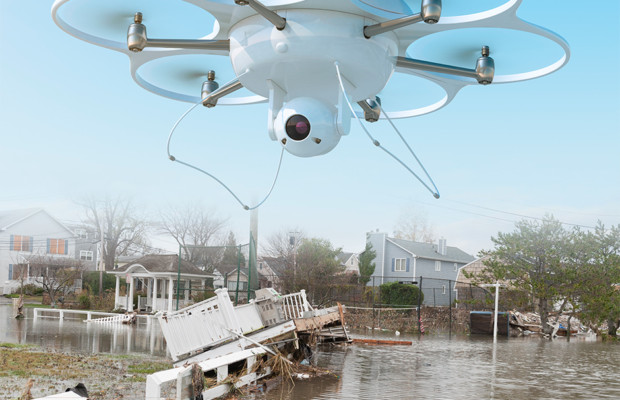Drones in Disaster Response

Could it be just a matter of time before drones become first responders in disaster situations? They’re quick, cost-effective, and programmable. A drone, or better, an unmanned aerial vehicle (UAV), does not operate like a remote-controlled helicopter. They are much more than toys: UAVs are sophisticated flying machines with applications we’ve only begun to explore for use in natural catastrophe situations.
The fate of a UAV does not lie in a joystick
At the most basic level, a UAV is a robot that follows the commands of its human user. But, don’t fret. It’s not quite what you may be thinking.
UAVs “know” when they’ve ventured out of range and will return to the original launch location. UAVs transform with additional hardware, making their usefulness in disaster response almost infinite. When an infrared camera is mounted to it, the UAV can detect body heat and help rescuers find survivors. Night-vision cameras keep searches active long after the sun goes down.
UAVs are mechanical daredevils that can enter risky situations that might otherwise jeopardize a pilot’s safety. Relative to full-size helicopters, UAVs are quiet and not disrupted by dust and debris. It is easier to hear shouts for help and to assess the disaster situation quickly. They’re also fast. UAVs can be up in a matter of minutes. So are drones better than a full-size helicopter? Not always. Most of the UAVs making news today are flyers & carriers; they can complement–but not replace–the human mind. And surveillance UAVs in the sky aren’t usually heavy lifters. It still takes man and machine to complete a rescue. But when it comes to collecting immediate visuals in rough circumstances, camera-mounted drones are much safer.
Checking on homes after a disaster
Once a storm passes, disaster response involves more than rescuers. Many groups must enter to assess the damage and determine safety. And this assessment takes place before emergency crews are allowed in affected areas. It could be days before evacuated homeowners can return to their homes. And when they do, insurance companies must be ready to help their customers rebuild their homes.
 With clearance and the use of UAVs equipped with cameras, insurers have an opportunity to get a head-start on assessing damage. This could be a great service to the affected homeowners, who are often left waiting in shelters to know the status of their homes.
With clearance and the use of UAVs equipped with cameras, insurers have an opportunity to get a head-start on assessing damage. This could be a great service to the affected homeowners, who are often left waiting in shelters to know the status of their homes.
Imagine a world where a drone signals to you that help is on the way or is the primary communicator showing you real-time imagery of your damaged home while you’re away. This can be helpful if the damage to your home requires immediate repair. Even a temporary tarp can go a long way in preventing further damage. It’s in everyone’s best interest to protect homes from structural damage. Insurance companies already have early response teams who assess losses after natural disasters. UAVs would make the process more efficient. Set the altitude, ready the remote, and watch the drone lift off to find which homes need immediate attention. Not bad for a toy helicopter.
Once the regulatory framework is in place, some experts believe it will create a $400 billion market. And according to the FAA, we can expect about 7,500 commercial UAVs in the sky.
What are your thoughts on the use of drones in disaster response? Any plans for when regulations are in place?
Posted in: Home, Insurance, Technology
Leave a Comment (0) ↓
